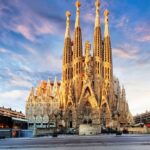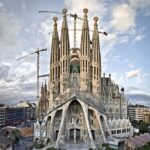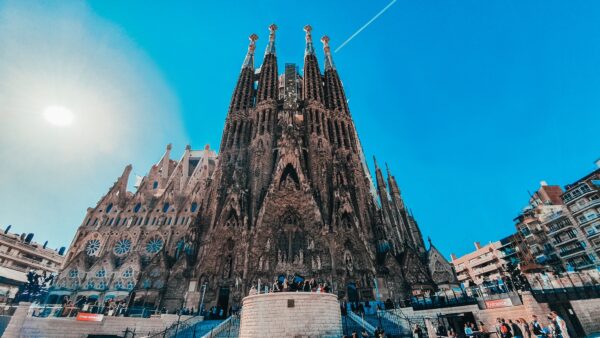
- The Fascinating History of Sagrada Familia: From Vision to Reality
- Sagrada Familia's Completion Date: What to Expect in the Future
- Must-See Attractions Inside Sagrada Familia: A Visitor's Guide
- Architectural Marvels of Sagrada Familia: Gaudí's Unique Design Elements
- Tips for Visiting Sagrada Familia: Making the Most of Your Experience
- Exploring the Symbolism Behind Sagrada Familia's Design and Colors
The Sagrada Familia, an iconic masterpiece designed by Antoni Gaudí, stands as a symbol of Barcelona's rich architectural heritage. This breathtaking basilica combines intricate details, unique forms, and profound religious significance, making it a must-visit destination for travelers from around the world.
In this article, we present The Complete Guide: Sagrada Familia in Barcelona - Finished Date, History and Must-See Attractions, where we delve into the fascinating history of this monumental structure, its anticipated completion date, and the key attractions that make it a remarkable experience for visitors. Prepare to explore the artistry and innovation that define Gaudí's vision.
The Fascinating History of Sagrada Familia: From Vision to Reality
The history of the Sagrada Familia is a tale of visionary ambition, starting with its groundbreaking in 1882. Initially designed by Francisco de Paula del Villar, the project soon attracted the genius of Antoni Gaudí, who took over in 1883. Gaudí envisioned a basilica that would harmonize with nature and reflect his deep religious beliefs, transforming a modest church plan into a grand architectural statement.
Over the years, the Sagrada Familia has faced numerous challenges, including financial constraints and the Spanish Civil War, which halted construction for years. Despite these setbacks, the dedication to complete Gaudí's dream persisted, driven by the efforts of various architects and craftsmen who have continued to work tirelessly on the basilica. Today, the project is funded primarily through private donations, illustrating the enduring public interest and support for Gaudí's masterpiece.
- 1882: Groundbreaking begins under Francisco de Paula del Villar.
- 1883: Antoni Gaudí takes over as lead architect.
- 1936: Construction halted due to the Spanish Civil War.
- 2026: Anticipated completion date, marking 100 years since Gaudí's death.
The amalgamation of Gothic and Art Nouveau styles in the Sagrada Familia is not merely aesthetic; it embodies Gaudí's profound understanding of nature and spirituality. Each façade and tower tells a part of the biblical story, making it a living catechism in stone. As work progresses towards the final phases, visitors can witness the evolution of Gaudí's vision, from his original sketches to the soaring structures that are becoming a reality.
Sagrada Familia's Completion Date: What to Expect in the Future
As anticipation builds around the completion date of the Sagrada Familia, slated for 2026, visitors can expect to witness the culmination of Gaudí's ambitious vision, which has evolved over more than a century. This milestone not only marks the 100th anniversary of Gaudí's death but also signifies a new chapter in the basilica's storied history. The final touches will enhance its spiritual message and architectural grandeur.
In the coming years, guests can look forward to several exciting developments, including:
- Enhanced Visitor Experience: New facilities and improved access will make the basilica more welcoming to tourists.
- Completion of Iconic Towers: The final towers will be erected, each symbolizing different aspects of faith.
- Artistic Installations: Ongoing artistic projects will further enrich the structure's narrative and aesthetic appeal.
As construction progresses, it will be fascinating to see how the artisans and architects balance modern techniques with Gaudí's original designs. The ongoing work serves as a living testament to the enduring legacy of Barcelona's architectural heritage. Visitors are encouraged to appreciate the transformative journey of the Sagrada Familia, where every visit reveals new elements of this architectural marvel.
Ultimately, the Sagrada Familia's completion will not only fulfill Gaudí's original dream but also inspire future generations to explore the intersections of art, faith, and culture. As the basilica approaches its long-awaited finish line, it promises to remain a centerpiece of Barcelona, captivating the hearts and minds of all who venture to witness its magnificence.
Must-See Attractions Inside Sagrada Familia: A Visitor's Guide
Once inside the Sagrada Familia, visitors are immediately captivated by the stunning interior, designed to mimic a forest of trees. The soaring columns, which branch out like tree trunks, create a sense of tranquility and spiritual elevation. Ensure to take a moment to appreciate the play of light coming through the stained glass windows, which flood the basilica with vibrant colors, enhancing the overall atmosphere of worship and wonder.
Among the must-see attractions inside, the Apse stands out with its breathtaking altar piece depicting the Last Supper. The intricately designed details reflect Gaudí's deep religious convictions and artistic flair. Be sure to explore the Nativity Facade, which represents the birth of Christ with elaborate sculptures that tell the story of this holy event. Each figure and scene is rich with symbolism, making it a profound experience for the visitors.
- Passion Facade: This façade depicts the suffering of Christ and contrasts sharply with the Nativity Facade, showcasing Gaudí's mastery of storytelling through architecture.
- Stained Glass Windows: The various hues create a magical interplay of light, enhancing the spiritual ambiance of the space.
- Gaudí's Workshop: A small exhibition area where visitors can see original sketches and models used by Gaudí, providing insight into his creative process.
- Crypt: This area contains the tomb of Gaudí and is a serene space for reflection, reminding visitors of the architect's lasting impact on this masterpiece.
Lastly, don’t miss the opportunity to visit the towers. While only a few are currently accessible, they offer breathtaking panoramic views of Barcelona. Standing at the top, one can truly grasp the scale and complexity of Gaudí's vision and the surrounding cityscape. As construction continues, more towers will open, adding to the awe-inspiring experience of this architectural wonder.
Architectural Marvels of Sagrada Familia: Gaudí's Unique Design Elements
The Sagrada Familia is not just a church; it is an architectural marvel that showcases Antoni Gaudí's innovative design elements. One of the most remarkable features is the use of hyperboloid structures, which allow for the creation of captivating shapes that mimic natural forms. These organic lines help the basilica to blend seamlessly with its surroundings, reflecting Gaudí's belief that architecture should coexist with nature.
Another unique aspect of Gaudí's design is the integration of light and color within the interior. The strategically placed stained glass windows are not only visually stunning but also serve a functional purpose, creating an ethereal atmosphere that changes throughout the day. This interplay of light enhances the spiritual experience for visitors, inviting them to connect with the sacred space.
Furthermore, the use of symbolism is prevalent in the Sagrada Familia’s design. Each façade and tower tells a story from the Bible, acting as a visual catechism for those who visit. For instance, the Nativity Facade is intricately adorned with sculptures that depict the birth of Christ, while the Passion Facade conveys the themes of suffering and sacrifice, showcasing Gaudí's deep religious convictions and artistic mastery.
Lastly, the basilica's verticality is a defining characteristic of Gaudí's architectural style. The towers, designed to reach toward the heavens, symbolize the aspiration of the faithful. As construction progresses, visitors can witness the gradual rise of these monumental structures, each representing a different aspect of Christian faith. This vertical emphasis not only enhances the basilica's grandeur but also serves to inspire awe and reverence among those who come to admire Gaudí's masterpiece.
Tips for Visiting Sagrada Familia: Making the Most of Your Experience
To make the most of your experience at the Sagrada Familia, consider purchasing your tickets online in advance. This not only helps you avoid long queues but also allows you to choose specific time slots that fit your schedule. Additionally, visiting during off-peak hours, typically early in the morning or late in the afternoon, can provide a more peaceful atmosphere to fully appreciate Gaudí's artistry.
When exploring the basilica, don't forget to take a guided tour. Knowledgeable guides can enrich your visit by providing insights into the history, architecture, and symbolism woven throughout the structure. Many tours also include access to areas that might not be open to general admission, allowing for a deeper understanding of Gaudí's vision and the ongoing construction efforts.
As you navigate the interior, be sure to pause and observe the stunning stained glass windows. The interplay of light and color creates a mesmerizing effect, transforming the space according to the sun's position. It's also worthwhile to spend time in the smaller chapels and the crypt, where Gaudí is buried; these quieter spots offer a moment of reflection amidst the grandeur.
Lastly, consider climbing one of the towers for a breathtaking view of Barcelona. While the ascent can be a bit challenging, the panoramic vistas are well worth the effort. Each tower is designed to reflect different aspects of faith, adding another layer of significance to your visit. Remember to bring your camera to capture these unforgettable sights!
Exploring the Symbolism Behind Sagrada Familia's Design and Colors
The design of the Sagrada Familia is a profound expression of symbolism that intertwines the spiritual and the natural. Gaudí meticulously crafted each element to convey deeper meanings, using forms and colors that resonate with religious themes. The basilica’s façades are laden with iconography, each telling stories from the Bible while reflecting Gaudí's vision of a sacred space that bridges heaven and earth.
The use of colors in the Sagrada Familia is particularly striking, with the stained glass windows serving as a vibrant narrative tool. The hues transform throughout the day, creating a dynamic atmosphere that enhances the spiritual experience. Visitors often note how the interplay of light and color evokes different emotions, drawing them into a reflective state as they admire the artistry surrounding them.
- Nativity Facade: Rich in colors and detailed sculptures representing the birth of Christ, symbolizing hope and new beginnings.
- Passion Facade: Uses stark contrasts and darker tones to convey themes of suffering and redemption.
- Interior Stained Glass: A palette that shifts from cool blues to warm reds, mirroring the cycle of life and spirituality.
Gaudí's integration of organic shapes further reinforces the connection between nature and spirituality. The basilica's columns, resembling tree trunks, create a forest-like ambiance, inviting visitors to experience a sanctuary rich in symbolism. This thoughtful design encourages reflection and connection, inviting believers and non-believers alike to ponder the mysteries of faith and existence within this magnificent structure.
 Discover the Majestic Sagrada Familia
Discover the Majestic Sagrada Familia Inside the Marvels of Barcelona: Exploring the Interior of the Sagrada Familia
Inside the Marvels of Barcelona: Exploring the Interior of the Sagrada Familia Discover the Majesty of Sagrada Familia: Barcelona's Iconic Gem
Discover the Majesty of Sagrada Familia: Barcelona's Iconic Gem Discover the Fascinating Facts about Sagrada Familia in Barcelona, Spain
Discover the Fascinating Facts about Sagrada Familia in Barcelona, SpainIf you want to know other articles similar to The Complete Guide: Sagrada Familia in Barcelona - Finished Date, History and Must-See Attractions you can visit the category WHERE YOU CAN GO.
Deja una respuesta










Read more!